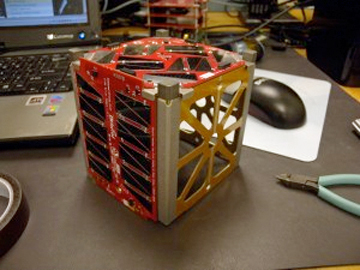
Photo of TJ3Sat.
The satellite, known as TJ3Sat (pronounced TJ-cube-sat), is one of 20 satellites selected by NASA as part of its CubeSat Launch Initiative, which includes cube-shaped research satellites that weigh approximately three pounds, also known as nanosatellites. TJ3Sat will serve primarily as an educational outreach tool and features a website that hosts live telemetry such as voltages, currents, temperatures, and other system status information available to the general public along with its history and other pertinent documents. TJ3Sat will also include a voice synthesizer that can be used to take uploaded strings of text and convert them to voice.
TJ alumnus Jason Ethier proposed the project as a result of an internship he served with Orbital Sciences Corporation. Teacher Adam Kemp then developed a course in systems engineering that would focus on the design and construction of the first high school-built satellite. A $30,000 donation from Orbital Sciences Corporation went toward the purchase of a cubesat kit, which formed the foundation of the satellite. Orbital has also provided the resources needed for the flight hardware, testing facilities for the finished spacecraft, and engineering mentorship by its employees.
Since 2006, teams of TJ students have been working on the design, construction, testing, and integration of TJ3Sat. Stensat LLC donated time, equipment, and expertise toward the development of the satellite.
Students used commercial off-the-shelf hardware for the structure of the satellite, radio, voice synthesizer, and a flight computer designed by Kemp. The remainder of the hardware was developed as student senior research projects under the advisement of Kemp, Orbital engineers, and other industry volunteers.
The voice synthesizer can be used by students around the world who can send messages to celebrate holidays, cheer on their sports teams, and communicate with friends and family across the globe.
It is estimated that TJ3Sat will be in orbit for at least three months, depending on the deployment and acquisition of orbital parameters.
The team has developed enough hardware to construct three satellites, all currently stored at Orbital’s facility in the Dulles area. Plans are to move one of the test satellites, known as engineering units, back to the school for use in troubleshooting the satellite once it is in space. Scale models of TJ3Sat are on display at the school.
Satellite team members have documented all their work and will offer the designs of the original hardware and software they developed on the website so that future K-12 institutions can refer to the information as a resource as they develop their own hardware.
Thomas Jefferson High is a Fairfax County public school. (Source:FairfaxNews.com)

